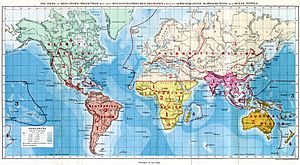Biogeography facts for kids
Biogeography is the study of where living things, like animals and plants, are found on Earth. It helps us understand why certain species live in specific places and why they might not be found in others.
This science shows how animals and plants are suited to their homes. But it also explains why places that look similar, like two deserts, can have very different kinds of animals and plants.
Biogeography helps us discover why this happens by studying species all over the world. In the 1800s, scientists called natural historians made lists of species in different areas. Later, Charles Darwin and Alfred Russel Wallace shared their big idea of evolution through natural selection. They traveled to tropical places to see why species fit their environments so well. They realized that evolution was key to understanding where species live.
New species usually form when an older species splits into two. This happens at a certain time and place. These new species might then travel to new areas. However, things like mountains, oceans, or different climates can stop them. This means some species might never reach certain places.
Because of this, two places with similar weather can have very different animals and plants. For example, marsupials (like kangaroos) live in Australia. Also, the Great American Interchange caused many different species to move between North and South America.
Different animals and plants move in different ways. Birds and insects can fly easily. Fish can swim in the sea. This is why North and South America have very different species, and why there aren't many types of freshwater fish that cross between continents.
So, we can say: "The farther apart countries are, the more different their animals and plants will be. And the closer they are, the more similar their animals and plants will be."
How Biogeography Started
The scientific study of biogeography grew from the work of many smart people. Some important names include Alexander von Humboldt, Alfred Russel Wallace, and Philip Sclater.
Wallace studied plants and animals in the Amazon River area and the Malay Archipelago (a group of islands in Southeast Asia) in the mid-1800s. Wallace and Sclater saw that biogeography strongly supported the idea of evolution. For example, the "Wallace Line" is an invisible boundary where animals on one side are very different from those on the other. This difference only makes sense when you think about evolution. Without evolution, biogeography would just be a list of where things live.
Both Darwin and Wallace paid close attention to oceanic islands. These islands are like natural laboratories for studying evolution, especially how new species form. Darwin did a lot of his work in the Galápagos Islands.
This interest in islands was renewed in 1967 by a book called The Theory of Island Biogeography. It was written by Robert MacArthur and E.O. Wilson. They showed that you could guess how many different species would be in an area if you knew its size, how many new species arrived, and how many species died out.
Scientists later realized that small pieces of natural areas, called habitat fragments, are like islands too. They can be studied in the same way. This idea helped create conservation biology, which is about protecting nature.
Today, scientists can use DNA analysis to test ideas about where groups of animals and plants came from and how they spread. This helps them understand the history of species.
Related topics
 In Spanish: Biogeografía para niños
In Spanish: Biogeografía para niños



